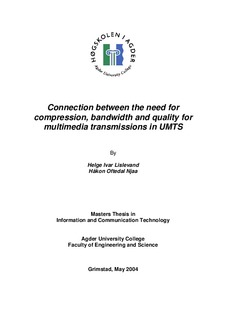| dc.description.abstract | The 1990s made mobile communication common among the majority in many countries, with user penetration as high as in the 80th percentile. The mobile telecommunication services has evolved from the analog services provided in the 1980s, to the current digital systems with limited packet data services, and further to the 3rd generation (3G) systems that are currently being rolled out across the world. These systems have been developed with extended data rate support in mind. They are specified to support transport of various data content, with different needs for bandwidth and delay constraints. Amongst these are voice-transportation, web browsing, video-streaming and video-telephony. The bandwidth limitations will of course remain, although with greater bandwidth one will be able to perform tasks that are difficult with today’s systems, like streaming video and video conferencing.
The need for compression will in the future be as high as ever. The increase in bandwidth usually leads to new fields of use i.e. new applications with higher demands for bandwidth. Examples of this are new phones with built in video cameras, and phones with high quality digital cameras. There has already been introduced a mobile phone with a built in 2 megapixel camera, and there is no reason to think that the development in this field will stop very soon. Online gaming on mobile devices is no longer science fiction; it will soon be a reality all over the world. These examples show that the need for efficient, high quality compression methods and algorithms are, and will remain high, in the years to come. The introduction of wavelet compression and the use of wavelets in the Joint Photographic Experts Group 2000 (JPEG 2000) standard is one example of new more efficient compression with high quality.
The UMTS standard is supposed to give the user data rates of up to 2Mbps. This is not a very likely transfer rate for most users. The transfer rates will most likely range from 12,2-384Kbps. Interference, movement and fading makes it very unlikely for a user to achieve higher transfer rates.
This thesis looks at image and video compression needs in Universal Mobile Telecommunication System (UMTS) in relation to bandwidth limitations and quality. We try to define what parameters that is most important for the quality of compressed pictures, and present what quality measurement techniques that are most widely used. We also present a quality measurement test based on wavelet-compressed images, where we show the perceptual difference of when a viewer is presented with an image with and without a reference. The subjective quality test is compared to objective measurements, and a conclusion is then presented.
The lack of suitable network simulation software has made it difficult, or to be precise impossible to present a fully working test system. We could have implemented a hardware based simulator, but decided that a task like that might be too time consuming. This being a fact we have made more effort in investigation of the compression and quality part of the thesis description. The focus of the thesis is at image, and image quality. There is not a lot of focus on video and video transmissions. Many of the parameters we discuss in the thesis will though be highly relevant when talking about transmissions of video. | en |
